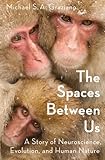The spaces between us : a story of neuroscience, evolution, and human nature / Michael S.A. Graziano.
By: Graziano, Michael S. A [author.].
Publisher: New York, NY : Oxford University Press, [2018]Description: viii, 202 pages : illustrations ; 25 cm.Content type: text Media type: unmediated Carrier type: volumeISBN: 9780190461010 (hardback).Subject(s): Cognitive neuroscience | Brain | Consciousness | Personal space | PSYCHOLOGY / Cognitive PsychologyGenre/Form: Print books.| Current location | Call number | Status | Date due | Barcode | Item holds |
|---|---|---|---|---|---|
| On Shelf | QP360.5 .G73 2018 (Browse shelf) | Available | AU00000000012340 |
Browsing Alfaisal University Shelves , Shelving location: On Shelf Close shelf browser

|

|

|

|

|

|

|
||
| QP360.5 .B55 2014 The power of neuroplasticity for pastoral and spiritual care / | QP360.5 .C3535 2018 The Cambridge handbook of the neuroscience of creativity / | QP360.5 .G566 2011 Foundations of neuroeconomic analysis / | QP360.5 .G73 2018 The spaces between us : a story of neuroscience, evolution, and human nature / | QP360.5 .H37 2016 The neurobiology of cognition and behavior / | QP360.5 .L49 2017 The undoing project : a friendship that changed our minds / | QP360.5 .M6684 2016 Moral brains : the neuroscience of morality / |
Includes bibliographical references and index.
Machine generated contents note: -- A Note On Terminology -- Chapter 1: The Second Skin -- Chapter 2: A Startling Discovery -- Chapter 3: The Flight Zone of the Zebra -- Chapter 4: The French Stare Too Much and My Lover Has A Bulgy Nose -- Chapter 5: Monkey Versus Ping Pong Ball -- Chapter 6: Kissing in the Dark -- Chapter 7: Hand-2-Mouth and Other Shocking Surprises of the Motor Cortex -- Chapter 8: Superflinchers and Nerves of Steel -- Chapter 9: The Peripersonal Radar In Humans -- Chapter 10: Wrapping Personal Space Around My Black & Decker -- Chapter 11: Why It's Sexy To Let A Vampire Bite Your Neck, And Other Social Consequences of Peripersonal Space -- Chapter 12: The First Smile -- Chapter 13: The First Laugh -- Chapter 14: The First Cry -- Chapter 15: The Personal Dimension of Personal Space.
" Each of us has a protected zone two or three feet wide, swelling around the head and narrowing towards the feet. This zone isn't fixed in size: if you're nervous, it grows; if you're relaxed, it shrinks. It also depends on your cultural upbringing. Personal space is small in Japan and large in Australia. This safety zone, called personal space, provides an invisible spatial scaffold that frames our social interactions. As Michael Graziano argues in The Spaces Between Us, it also organizes our social and emotional spacing, influences our facial expressions, and shapes our interactions with everyday objects including tools, furniture, and clothing. Even ordinary actions like walking are informed by a continuous under-the-surface calculation of threats and obstacles around the body: what Graziano calls a virtual bubble-wrap of active neurons that fire and move us to action, even before we may be conscious of our course corrections in real time. Humans evolved a complex way of interacting with others and their environment, and The Spaces Between Us looks at how this infrastructure may have led to the first smile and to a host of other human activities, from tool use, to courtship, and to a sense of self. The book concludes with a case study of Graziano's son, who had heart-breaking difficulties developing a functioning personal space. Written with poignant narrative clarity, Graziano makes the case for the interested scientific public that this system in the brain is more than a fascinating scientific topic: it's deeply personal and shapes our human nature. "--
"Hidden beneath consciousness, the brain mechanisms of personal space affect every aspect of our lives - social, emotional, cultural, and practical"--


